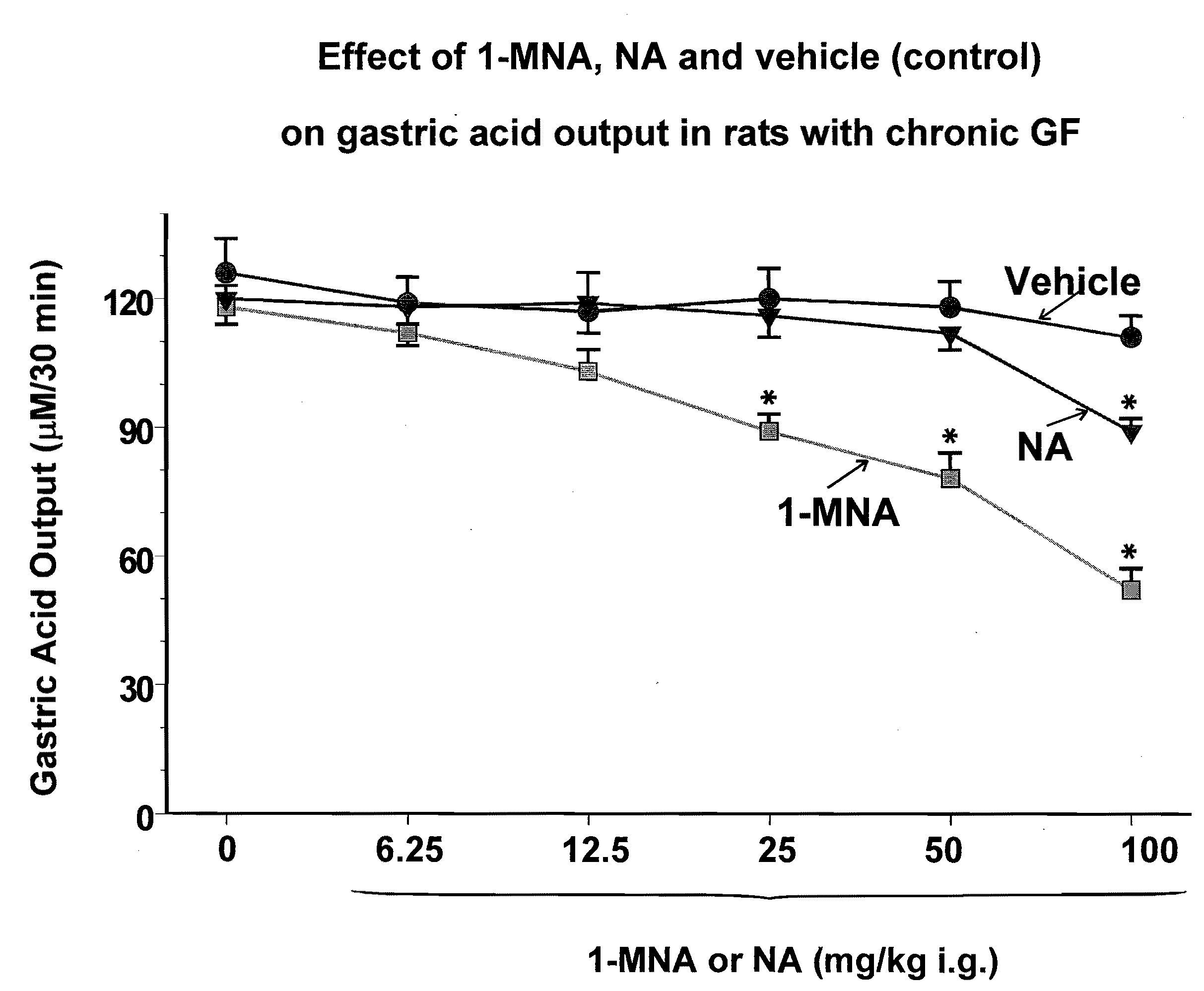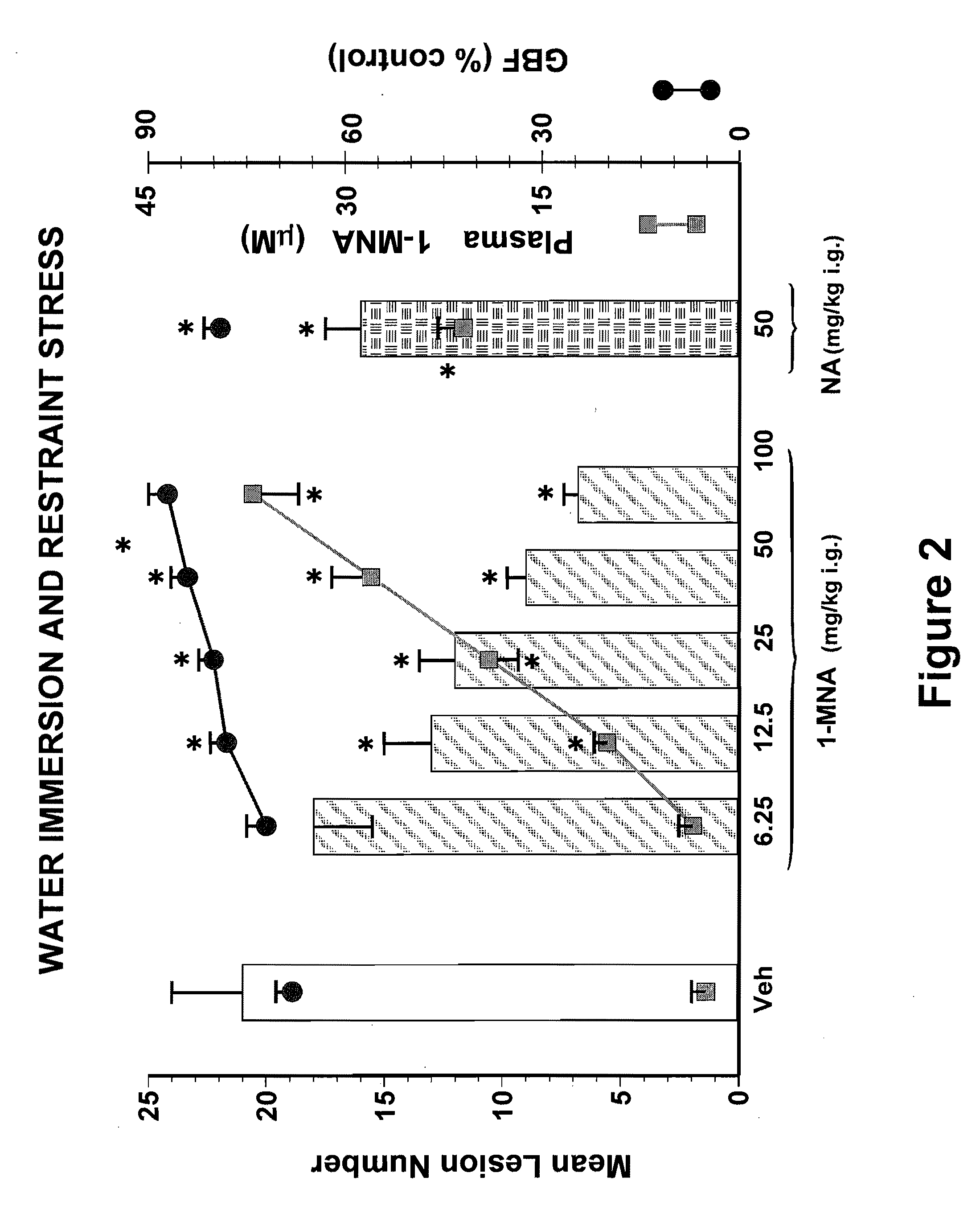1-Methyl Nicotinamide and Derivatives for Treatment of Gastric Injury
a technology of nicotinamide and nicotinamide, which is applied in the direction of heterocyclic compound active ingredients, biocide, drug compositions, etc., can solve the problems of peptic ulcers, gastrointestinal problems are common, and the burning and pressure symptoms of heartburn can last a long tim
- Summary
- Abstract
- Description
- Claims
- Application Information
AI Technical Summary
Problems solved by technology
Method used
Image
Examples
example 1
Production of Gastric Lesions
[0149]Male Wistar rats, weighing 180-220 grams were fasted for 24 hours before subjecting to experimentation were employed in all studies. The animals were divided into groups for the following types of induced gastric lesions: ethanol-; aspirin (acetylsalicylic acid; ASA)-; stress-; and ischemia-reperfusion (I / R)-induced gastric lesions. In the first group, gastric lesions were produced by intragastric (i.g.) application of ethanol (75%), in the second group by i.g. application of acidified ASA (125 mg / kg), in the third group by animal exposure to 3.5 hours of water immersion (and restraint stress (WRS), in the fourth group by ischemia (by clamping celiac artery for 30 minutes followed by release of the clamp (reperfusion for 3 hours) (I / R).
[0150]The following experiments were designed to assess the therapeutic effect of 1-MNA on induced gastric lesions. Vehicle (saline) or 1-MNA (6.25-200 mg / kg i.p.) was administered 30 minutes prior to subjecting the ...
example 2
Measurements of Gastric Lesions
[0155]Gastric Blood Flow:
[0156]To assess gastric blood flow (GBF) laser Doppler flowmeter (Laserflo, model BPM 403A, Blood Perfusion Monitor, Vasamedics, St. Paul, Minn., USA) was used. The animals were anaesthetized with Vetbutal 50 mg / kg (Biowet, Pu3awy, Poland), then the abdomen was opened and the stomach was exposed to assess the GBF. Blood flow was measured on anterior and posterior wall of stomach. The mean values of these measurements were calculated and expressed as percent change from value recorded in the intact mucosa.
[0157]Area of Lesions:
[0158]To establish the number and area of gastric lesions, computerized planimetry (Morphomat, Carl Zeiss, Berlin, Germany) was used. Results are expressed as mm.
[0159]Determination of Plasma IL-1β and TNFα Levels
[0160]A venous blood sample was withdrawn from the vena cava into EDTA-containing vials in order to determine the plasma level of interleukin-1 beta (IL-1β) and tumor necrosis factor alpha (TNFα) ...
example 3
Evaluation of 1-MNA on Gastric Lesions
Water Immersion and Restraint Stress Model (WRS)
[0167]The following experiments were designed to compare the effects of pretreatment with vehicle and 1-MNA or NA on stress-induced gastric lesions and the accompanying changes in gastric blood flow (GBF) and gastric tissue activities of MDA and SOD and plasma pro-inflammatory cytokine IL-1β and TNF-α levels. These sets of experiments were based on the observation that 1-MNA was able to reduce the gastric output in rats having chronic gastric fistula (GF). Rats with chronic GF were administered with 1-MNA, NA, or a vehicle control. It was observed that 1-MNA was able to decrease the gastric acid output in chronic GF rats. The ability of 1-MNA to inhibit gastric output increased with increasing dosage of 1-MNA administered to the rats. 1-MNA was observed to suppress gastric acid output more effectively than NA (FIG. 1).
[0168]Pretreatment with 1-MNA resulted in decreased lesion number and increased g...
PUM
| Property | Measurement | Unit |
|---|---|---|
| time | aaaaa | aaaaa |
| time | aaaaa | aaaaa |
| pH | aaaaa | aaaaa |
Abstract
Description
Claims
Application Information
 Login to View More
Login to View More - R&D
- Intellectual Property
- Life Sciences
- Materials
- Tech Scout
- Unparalleled Data Quality
- Higher Quality Content
- 60% Fewer Hallucinations
Browse by: Latest US Patents, China's latest patents, Technical Efficacy Thesaurus, Application Domain, Technology Topic, Popular Technical Reports.
© 2025 PatSnap. All rights reserved.Legal|Privacy policy|Modern Slavery Act Transparency Statement|Sitemap|About US| Contact US: help@patsnap.com



